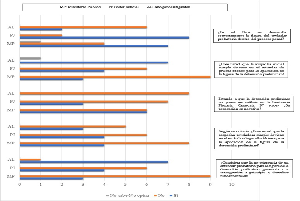The evidentiary standard of judicial preliminary detention in the Peruvian criminal process
DOI:
https://doi.org/10.51252/rcri.v2i2.362Keywords:
constitutional status, test standard, preparatory investigation, principle of legality, last ratio principleAbstract
The general purpose of this article was to determine the standards of the professional role of the defense attorney and the effective exercise of the right of defense in the trial stage, for which it was analyzed from a systematic approach. The method used in the present investigation is qualitative, said method supported by grounded theory has had semi-structured interviews as an instrument for its development; as well as, analysis of cases of great importance within our country. The results show that there is no evidentiary standard currently regulated within our criminal legal system that can establish margins of use, generating this indiscriminate use by our authorities or an erroneous interpretation with the Plenary Casatoria Judgment N°. 1-2017, which establishes evidentiary standards for other sub-stages and stages of the criminal process. In conclusion, the standard of proof for preliminary detention is in the limbo of the preliminary proceedings and the formalization of the preparatory investigation, and that it seriously affects human freedom, therefore, as a measure, the position that this may be viable only with the suspicion that is used to initiate the preliminary proceedings.
Downloads
References
Cáceres Julca, R. (2017). Medidas de coerción en el nuevo Código Procesal Penal. https://img.lpderecho.pe/wp-content/uploads/2017/09/Legis.pe-Manual-de-medidas-de-coerción-2017.pdf
Chávez Hurtado, R. (2020). Los presupuestos materiales para la detención preliminar judicial en el supuesto de no flagrancia delictiva. https://cejamericas.org/wp-content/uploads/2020/09/RCHAVEZ_lospresupuestosmateriales.pdf
IDEHPUCP. (2019). Instituto de democracia y derechos humanos. https://idehpucp.pucp.edu.pe/observatorio-de-casos-anticorrupcion-y-lavado-de-activos/casos-materia-corrupcion/cuellos-blancos/
La Ley - El Ángulo Legal de la Noticia. (2020). DE DETENIDO A PRESO: ¿Se está instrumentalizando la detención preliminar? https://laley.pe/art/10174/de-detenido-a-preso-se-esta-instrumentalizando-la-detencion-preliminar
Ortiz García, J. E. (2021). Vinculación a proceso. Análisis al estándar probatorio . Revista de La Facultad de Derecho de México, 21(279), 286–310. http://www.revistas.unam.mx/index.php/rfdm/article/view/75864/69677
Prütting, H. (2010). Carga de la prueba y estándar probatorio: la influencia de Leo Rosenberg y Karl Hainz Schwab para el desarrollo del moderno derecho probatorio. Ius et Praxis, 16(1), 453–464. https://doi.org/10.4067/S0718-00122010000100015
Sardá Lloga, E. A., Desloy Hechavarría, D. K., & Medina Marcheco, T. B. (2020). Audiencia Preliminar y disminución del Estándar Probatorio. Apuntes para una reforma procesal en Cuba. Estudios de Derecho, 77(170), 71–94. https://doi.org/10.17533/udea.esde.v77n170a03
Silva Sánchez, A. S. (2018). El estándar probatorio de la actividad criminal previa del delito de lavado de activos conforme a la sentencia plenaria casatoria Na1-2017 y su repercusiòn en el proceso penal peruano [Universidad de San Martín de Porres]. https://hdl.handle.net/20.500.12727/4964
Vásquez-Mejía, R. F., & Trelles-Vicuña, D. F. (2020). La constitucionalidad de la detención con fines investigativos en el Ecuador. Polo Del Conocimiento, 5(8), 216–249. https://doi.org/10.23857/PC.V5I8.1586
Villagra Castillo, E. A. (2018). Hacia la formulación de un estándar de prueba cautelar aplicable a la prisión preventiva desde la mirada de la presunción de inocencia [Universidad de Chile]. https://repositorio.uchile.cl/handle/2250/146869

Published
How to Cite
Issue
Section
License
Copyright (c) 2022 Richard Rodríguez-Alván

This work is licensed under a Creative Commons Attribution 4.0 International License.
The authors retain their rights:
a. The authors retain their trademark and patent rights, as well as any process or procedure described in the article.
b. The authors retain the right to share, copy, distribute, execute and publicly communicate the article published in the Ratio Iure Scientific Journal (RCRI) (for example, place it in an institutional repository or publish it in a book), with an acknowledgment of its initial publication in the RCRI.
c. Authors retain the right to make a subsequent publication of their work, to use the article or any part of it (for example: a compilation of their works, notes for conferences, thesis, or for a book), provided that they indicate the source of publication (authors of the work, journal, volume, number and date).






